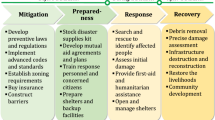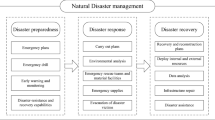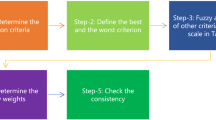Abstract
Disaster management is one of the most important issues in service organizations, especially in healthcare sector. Due to the occurrences of natural or human-made incidents, requirements of assistance and rescue increase gradually. Hospitals have the vital role in addressing these requirements and therefore should enhance their skill to provide a punctual and appropriate response to these events. An important prerequisite for this level of responsiveness is agility. This study aims to introduce and implement a new approach in order to estimate the agility level of hospitals in disaster management. Founded on the four phases of disaster management, a hospital agility framework is established which showcases the relations between hospital agility factors and phases of disaster management. A new Flowsort-based approach is also introduced through the integration of the conventional Flowsort method with interval type-2 fuzzy sets. This approach is applied for a case study consisting of 30 hospitals seeking to improve their agility in disasters. We use upper and lower control limits (UCL and LCL) to define the categories of Flowsort method. The results show that 40% of the hospitals position in between the \( \pm \,2\delta \) and \( \pm \,3\delta \) limits, i.e., the best and the worst categories. Results also approve the ability of the proposed method in evaluation of hospitals based on their agility factors and represent a geographical observation on the hospitals. Some indications about required actions for hospitals of each category in order to increase or maintain their agility level in disaster management are also provided.





Similar content being viewed by others
References
Abbasbandy S, Asady B (2006) Ranking of fuzzy numbers by sign distance. Inf Sci 176(16):2405–2416
Abbasi M, Hossein Salehnia M (2013) Disaster medical assistance teams after earthquakes in Iran: propose a localized model. Iran Red Crescent Med J 15(9):829–835
Abdi F (2018) Hospital leanness assessment model: a fuzzy MULTI-MOORA decision making approach. J Ind Syst Eng 11(3):37–59
Acharya L, Upadhya KD, Kortmann F (2006) Mental health and psychosocial support aspects in disaster preparedness: Nepal. Int Rev Psychiatry 18(6):587–592
Adebanjo D, Laosirihongthong T, Samaranayake P (2016) Prioritizing lean supply chain management initiatives in healthcare service operations: a fuzzy AHP approach. Prod Plan Control 27(12):953–966
Akenroye TO, Kuenne CW (2015) Key competencies for promoting service innovation: what are implications for the health sector? Innov J 20(1):1–21
Akter S, Fosso S (2019) Big data and disaster management: a systematic review and agenda for future research. Ann Oper Res 283(1–2):939–959
Alaszewski A (2002) The impact of the Bristol royal infirmary disaster and inquiry on public services in the UK. J Interprof Care 16(4):371–378
Alruwaili A, Islam S, Usher K (2019) Disaster preparedness in hospitals in the middle east: an integrative literature review. Disaster Med Public Health Prepared 13(4):1–11
Ashrafi N et al (2005) A framework for implementing business agility through knowledge management systems. In: Proceedings—7th IEEE international conference on e-commerce technology workshops, CEC 2005 workshops, 2005, pp 116–121. https://doi.org/10.1109/cecw.2005.2
Ayyildiz E, Taskin Gumus A, Erkan M (2020) Individual credit ranking by an integrated interval type-2 trapezoidal fuzzy Electre methodology. Soft Comput. https://doi.org/10.1007/s00500-020-04929-1
Azami-Aghdash S, Tabrizi JS, Bazargani HS (2015) Developing performance indicators for clinical governance in dimensions of risk management and clinical effectiveness. Int J Qual Health Care 27(2):110–116
Bahrainy H (2003) Natural disaster management in Iran during the 1990s—need for a new structure. J Urban Plan Dev 129(3):140–160
Brans JP, Vincke P (1985) Note—a preference ranking organisation method. Manag Sci 31(6):647–656
Campos ACSM, Mareschal B, De Almeida AT (2015) Fuzzy FlowSort: an integration of the FlowSort method and fuzzy set theory for decision making on the basis of inaccurate quantitative data. Inf Sci 293(February):115–124
Chen TY (2011) An integrated approach for assessing criterion importance with interval type-2 fuzzy sets and signed distances. J Chin Inst Ind Eng 28(8):553–572
Chen T (2014a) A PROMETHEE-based outranking method for multiple criteria decision analysis with interval type-2 fuzzy sets. Soft Comput 18(4):923–940
Chen TY (2014b) A PROMETHEE-based outranking method for multiple criteria decision analysis with interval type-2 fuzzy sets. Soft Comput 18(5):923–940
Chen TY (2014c) An ELECTRE-based outranking method for multiple criteria group decision making using interval type-2 fuzzy sets. Inf Sci 263:1–21
Chenoweth D, Peters M, Naremore B (2006) Disaster recovery and outsourcing. Hospital systems recovery in a worst case scenario. Health Manag Technol 27(2):36–42
Dahiyat SE (2004) Exploring organisational agility in healthcare: a case study investigation. Thesis for Doctor of Philosophy, University of Huddersfield. http://eprints.hud.ac.uk/id/eprint/20023/
Dahmardeh N, Banihashemi SA (2010) Organizatinal agility and agile manufacturing. Eur J Econ Finance Adm Sci 27:178–184
De A, Kundu P, Das S, Kar S (2020) A ranking method based on interval type-2 fuzzy sets for multiple attribute group decision making. Soft Comput 24(1):131–154
Dickens PM (2013) Facilitating emergent change in a healthcare setting. Healthc Manag Forum 26(3):116–120
Disaster Statistics—UNDRR (no date). https://www.unisdr.org/we/inform/disaster-statistics. Accessed 1 Dec 2019
Donaldson L (1998) Risk and crisis management in the public sector: commentary: clinical governance and service failure in the NHS. Public Money Manag 18(4):10–11
Farhadinia B, Herrera-Viedma E (2019) Sorting of decision-making methods based on their outcomes using dominance-vector hesitant fuzzy-based distance. Soft Comput 23(4):1109–1121. https://doi.org/10.1007/s00500-018-3143-8
Ganguly A, Nilchiani R, Farr JV (2009) Evaluating agility in corporate enterprises. Int J Prod Econ 118(2):410–423
Giardino JR, Houser C (2015) A summary and future direction of the principles and dynamics of the critical zone. Dev Earth Surf Process 19:619–628
Gil JCS, McNeil S (2015) Supply chain outsourcing in response to manmade and natural disasters in Colombia, a humanitarian logistics perspective. Proc Eng 107:110–121
Gordon M, Poncelet JL, Dubouloz M, Briceno S (2019) Panel 2. 12: the health sector contribution to disaster reduction. Prehosp Disaster Med 20(6):439–441
Grigg NS (2012) Large-scale disasters: leadership and management lessons. Leadersh Manag Eng 12(3):97–100
Guimarães CM, de Carvalho JC (2012) Outsourcing in healthcare through process modularization—a lean perspective. Int J Eng Bus Manag 4(1):1–12
Gul M, Celik E, Gumus AT, Guneri AF (2016) Emergency department performance evaluation by an integrated simulation and interval type-2 fuzzy MCDM-based scenario analysis. Eur J Ind Eng 10(2):196–223
Harrald JR (2006) Agility and discipline: critical success factors for disaster response. Ann Am Acad Polit Soc Sci 604(1):256–272
Harrison JP, Harrison RA, Smith M (2008) Role of information technology in disaster medical response. Health Care Manag 27(4):307–313
Hori E, Inoue Y, Sekino M, Hasemi Y (2016) Research about the medical equipment load at the time of disaster. J Environ Eng 81(725):625–632
Hu J, Zhang Y, Chen X, Liu Y (2013) Multi-criteria decision making method based on possibility degree of interval type-2 fuzzy number. Knowl Based Syst 43(May):21–29
Hussain M, Malik M, Al Neyadi HS (2016) AHP framework to assist lean deployment in Abu Dhabi public healthcare delivery system. Bus Process Manage J 22:20
Ishizaka A, Pereira V (2019) Utilisation of ANPSort for sorting alternative with interdependent criteria illustrated through a researcher’s classification problem in an academic context. Soft Comput 2019:1–12
Islam S, Khan S, Sharma RK (2012) Role of recent technology in disaster management. Int J Res Rev Eng Sci Technol 1(3):35–40
Jana DK, Pramanik S, Sahoo P, Mukherjee A (2019) Interval type-2 fuzzy logic and its application to occupational safety risk performance in industries. Soft Comput 23(2):557–567
Janssen P, Nemery P (2013) An extension of the FlowSort sorting method to deal with imprecision. 4OR 11(2):171–193
Kamissoko D, Zaraté P, Pérès F (2014) Decision process in large-scale crisis management. Environ Syst Decis 34(2):277–287. https://doi.org/10.1007/s10669-014-9498-1
Karanik M, Bernal R, Pelaez JI, Ruiz JAG (2019) Combining user preferences and expert opinions: a criteria synergy-based model for decision making on the web. Soft Comput 23(4):1357–1373
Kitzmiller R, Hunt E, Sproat SB (2006) Adopting best practices: “agility” moves from software development to healthcare project management. CIN Comput Inf Nurs 24(2):75–82
Koshy T (2014) Leadership impact on healthcare organizational behavior | LinkedIn. https://www.linkedin.com/pulse/20140915033433-34529931-leadership-impact-on-healthcare-organizational-behavior/. Accessed: 24 Apr 2020
Kumagai Y, Edwards J, Carroll MS (2006) Why are natural disasters not “natural” for victims? Environ Impact Assess Rev 26(1):106–119
Lam RPK, Balsari S, Hung KKC, Hsiao KH, Leung LP, Leaning J (2018) How do doctors and nurses in emergency departments in Hong Kong view their disaster preparedness? A cross-sectional territory-wide online survey. Disaster Med Public Health Prepared 12(3):329–336
Lolli F, Ishizaka A, Gamberini R, Rimini B, Messori M (2015) FlowSort-GDSS—a novel group multi-criteria decision support system for sorting problems with application to FMEA. Expert Syst Appl 42(17–18):6342–6349
Lu Y (2011) Understanding the link between information technology capability and organizational agility: an empirical examination. MIS Q 35(4):931–954
Martin A (2015) Talent management: preparing a “ready” agile workforce. Int J Pediatr Adolesc Med 2(3–4):112–116
Mendel JM, John RI, Liu F (2006) Interval type-2 fuzzy logic systems made simple. IEEE Trans Fuzzy Syst 14(6):808–821
Miller S, Gongora M, Garibaldi J, John R (2012) Interval type-2 fuzzy modelling and stochastic search for real-world inventory management. Soft Comput 16(8):1447–1459
Nemery P (2009) On the use of multicriteria ranking methods in sorting problems. Docteur en sciences de l’ ingenieur, Faculté des Sciences Appliquées. http://www.nemery.net/page3/Nemery_Philippe_PhD.pdf
Nemery P, Lamboray C (2008) Flow sort: a flow-based sorting method with limiting or central profiles. Top 16(1):90–113
Nemery P et al (2012) Enriching descriptive information in ranking and sorting problems with visualizations techniques. J Model Manag 7(2):130–147
Ortiz-Barrios M, Gul M, López-Meza P, Yucesan M, Navarro-Jiménez E (2020) Evaluation of hospital disaster preparedness by a multi-criteria decision making approach: the case of Turkish hospitals. Int J Disaster Risk Reduct 2020:101748
Patri R, Suresh M (2017) Modelling the enablers of agile performance in healthcare organization: a TISM approach. Glob J Flex Syst Manag 18(3):251–272
Patricelli F, Beakley JE, Carnevale A, Tarabochia M, von Lubitz DK (2009) Disaster management and mitigation: the telecommunications infrastructure. Disasters 33(1):23–37
Pelissari R, Oliveira MC, Amor SB, Abackerli AJ (2019) A new FlowSort-based method to deal with information imperfections in sorting decision-making problems. Eur J Oper Res 276(1):235–246
Peña A et al (2019) A fuzzy ELECTRE structure methodology to assess big data maturity in healthcare SMEs. Soft Comput 23(20):10537–10550
Pereira J, de Oliveira ECB, Gomes LFAM, Araujo RM (2019) Sorting retail locations in a large urban city by using ELECTRE TRI-C and trapezoidal fuzzy numbers. Soft Comput 23(12):4193–4206
Persoff J, Ornoff D, Little C (2018) the role of hospital medicine in emergency preparedness: a framework for hospitalist leadership in disaster preparedness, response, and recovery. J Hosp Med 13(10):713–718. https://doi.org/10.12788/jhm.3073
Pfefferbaum et al (2012) The integration of mental and behavioral health into disaster preparedness, response, and recovery. Disaster Med Public Health Prepared 6(1):60–66
Qin J, Liu X, Pedrycz W (2017) A multiple attribute interval type-2 fuzzy group decision making and its application to supplier selection with extended LINMAP method. Soft Comput 21(12):3207–3226
Reddy SD (2000) Factors influencing the incorporation of hazard mitigation during recovery from disaster. Nat Hazards 22(2):185–201
Reilly MJ, Markenson D (2010) Hospital referral patterns: how emergency medical care is accessed in a disaster. Disaster Med Public Health Prepared 4(3):226–231
Sang X, Liu X (2016) An analytical solution to the TOPSIS model with interval type-2 fuzzy sets. Soft Comput 20(3):1213–1230
Satapathy S, Banerjee A, Bahl A (2011) (A217) success indicators of emergency medical management: a building collapse disaster. Prehosp Disaster Med 26(S1):s60. https://doi.org/10.1017/s1049023x1100207x
Sepulveda J, Gonzalez J, Alfaro M, Camargo M (2010) A metrics-based diagnosis tool for enhancing innovation capabilities in SMEs. Int J Comput Commun Control 5(5):919–928
Sherehiy B, Karwowski W, Layer JK (2007) A review of enterprise agility: concepts, frameworks, and attributes. Int J Ind Ergon 37(5):445–460
Sindhwani R, Singh PL, Iqbal A, Prajapati DK, Mittal TK (2019) ‘Modeling and analysis of factors influencing agility in healthcare organizations: an ISM approach. Adv Ind Prod Eng. https://doi.org/10.1007/978-981-13-6412-9_64
Singh PK (2019) Bipolar fuzzy concept learning using next neighbor and Euclidean distance. Soft Comput 23(12):4503–4520
Sinha A, Kumar P, Rana NP, Islam R, Dwivedi YK (2019) Impact of internet of things (IoT) in disaster management: a task-technology fit perspective. Ann Oper Res 283(1–2):759–794
Suresh M, Patri R (2017) Agility assessment using fuzzy logic approach: a case of healthcare dispensary. BMC Health Serv Res 17(1):1–13
Suresh M, Vaishnavi V, Pai RD (2020) Leanness evaluation in health-care organizations using fuzzy logic approach. Int J Organ Anal. https://doi.org/10.1108/IJOA-04-2019-1752
Sushil (2019) Theory building using SAP-LAP linkages: an application in the context of disaster management. Ann Oper Res 283(1–2):811–836
Talib F, Rahman Z (2015) An interpretive structural modelling for sustainable healthcare quality dimensions in hospital services. Int J Qual Res Serv 2(1):28–46
Tolf S (2017) Lean, agile, and lean and agile hospital management public health care. Thesis of doctoral degree. https://openarchive.ki.se/xmlui/handle/10616/45887
Tolf S, Nystrom ME, Tishelman C (2015) Agile, a guiding principle for health care improvement? Int J Health Care Qual Assur 28(5):468–493
Topaloglu M, Yarkin F, Kaya T (2018) Solid waste collection system selection for smart cities based on a type-2 fuzzy multi-criteria decision technique. Soft Comput 22(15):4879–4890
Vaishnavi V, Suresh M, Dutta P (2019) Modelling the readiness factors for agility in healthcare organization: an TISM approach. Benchmarking 26(7):2372–2400
Van Assche D, De Smet Y (2016) FlowSort parameters elicitation based on categorisation examples. Int J Multicrit Decis Mak 6(3):191–210
Veenema TG, Adam BR, MaryCasey L, Janice S, Mary K (2015) Quality of healthcare services provided in disaster shelters: an integrative literature review. Int Emerg Nurs 23(3):225–231
Verheyden T, De Moor L (2014) Sorting mutual funds with respect to process-oriented social responsibility: a flowshort application. Decis Sci Lett 3(4):551–562
Wang YJ (2020) Utilization of trapezoidal intuitionistic fuzzy numbers and extended fuzzy preference relation for multi-criteria group decision-making based on individual differentiation of decision-makers. Soft Comput 24(1):397–407
Wang X, Wu Y, Liang L, Huang Z (2016) Service outsourcing and disaster response methods in a relief supply chain. Ann Oper Res 240(2):471–487
Wen M, Zhao H, Xu Z (2019) Hesitant fuzzy Lukasiewicz implication operation and its application to alternatives’ sorting and clustering analysis. Soft Comput 23(2):393–405. https://doi.org/10.1007/s00500-018-3359-7
Wright NA, Foster L (2018) Improving disaster response through the science of work. Int J Disaster Risk Reduct 31(October):112–120
Yucesan M, Gul M (2020) Hospital service quality evaluation: an integrated model based on pythagorean fuzzy AHP and fuzzy TOPSIS. Soft Comput 24(5):3237–3255
Zusman EE, Marghella PD (2013) Disaster management in the era of lean healthcare. Neurosurgery 72(2):N11–N14. https://doi.org/10.1227/01.neu.0000426210.89959.f5
Acknowledgment
The authors would like to express their sincerest thanks to the potential editors and reviewers for constructive suggestions to enhance the clarity of the previous version of the article.
Funding
The study is not funded by any agency.
Author information
Authors and Affiliations
Corresponding author
Ethics declarations
Conflict of interests
The authors do hereby declare that there is no conflict of interests of other works regarding the publication of this paper.
Human and animal rights
This article does not contain any studies with human participants or animals performed by any of the authors.
Additional information
Communicated by V. Loia.
Publisher's Note
Springer Nature remains neutral with regard to jurisdictional claims in published maps and institutional affiliations.
Rights and permissions
About this article
Cite this article
Moheimani, A., Sheikh, R., Hosseini, S.M.H. et al. Assessing the agility of hospitals in disaster management: application of interval type-2 fuzzy Flowsort inference system. Soft Comput 25, 3955–3974 (2021). https://doi.org/10.1007/s00500-020-05418-1
Published:
Issue Date:
DOI: https://doi.org/10.1007/s00500-020-05418-1




